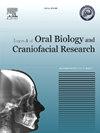牙种植体识别的先进深度学习技术
Q1 Medicine
Journal of oral biology and craniofacial research
Pub Date : 2025-02-08
DOI:10.1016/j.jobcr.2025.01.016
引用次数: 0
摘要
牙种植体是目前最普遍接受的缺牙修复方法。随着需求的增长,一些制造商已经进入市场,并生产各种品牌的植入物,这给临床医生在必要时识别植入物带来了挑战。目前,x光片是唯一的工具来识别种植体,这本身是一个复杂的过程,因此需要种植体识别技术。能够分析x光片中的图像并预测植入物类型的人工智能是一种有效的工具。该研究评估了一种先进的深度学习技术,检测变压器用于植入物识别。方法采用基于变压器的深度学习技术,训练DEtection transformer识别x线片中的植入物。研究选择了1138张图像数据集,包括从根尖周围和全景x线片捕获的五种种植体类型。增强后,保护了1744张图像的数据集,然后将其分为模型的训练、验证和测试数据集。对模型进行了训练并对其性能进行了评估。结果该模型的总体准确率为0.83,召回率为0.89。该模型的f1得分为0.82,表明在召回率和精度之间取得了良好的平衡。精确召回曲线(Precision-Recall Curve)的AUC为0.96,表明该模型在不同阈值下均表现良好。训练和验证图显示了跨类损失函数的一致减少。结论该模型在训练数据上表现出较好的性能,但存在验证数据不可见的问题。较高的准确率、召回率和F1分数表明该模型具有识别植入物的潜力。优化该模型以平衡准确性和效率将是实时医学成像应用的必要条件。本文章由计算机程序翻译,如有差异,请以英文原文为准。

Advanced deep learning techniques for recognition of dental implants
Background
Dental implants are the most accepted prosthetic alternative for missing teeth. With growing demands, several manufacturers have entered the market and produce a variety of implant brands creating a challenge for clinicians to identify the implant when the necessity arises. Currently, radiographs are the only tools for implant identification which is inherently a complex process, hence the need for implant identification technique. Artificial intelligence capable of analysing images in a radiograph and predicting implant type is an efficient tool. The study evaluated an advanced deep learning technique, DEtection TRanformer for implant identification.
Methods
A transformer-based deep learning technique, DEtection TRanformer was trained to identify implants in radiographs. A dataset of 1138 images consisting of five implant types captured from periapical and panoramic radiographs was chosen for the study. After augmentation, a dataset of 1744 images was secured and then split into training, validation and test datasets for the model. The model was trained and evaluated for its performance.
Results
The model achieved an overall precision of 0.83 and a recall score of 0.89. The model achieved an F1-score of 0.82 indicating a strong balance between recall and precision. The Precision-Recall Curve, with an AUC of 0.96, showed that the model performed well across various thresholds. The training and validation graphs showed a consistent decrease in the loss functions across classes.
Conclusion
The model showed high performance on the training data, though it faced challenges with unseen validation data. High precision, recall and F1 score indicate the model's potential for implant identification. Optimizing this model for a balance between accuracy and efficiency will be necessary for real-time medical imaging applications.
求助全文
通过发布文献求助,成功后即可免费获取论文全文。
去求助
来源期刊

Journal of oral biology and craniofacial research
Medicine-Otorhinolaryngology
CiteScore
4.90
自引率
0.00%
发文量
133
审稿时长
167 days
期刊介绍:
Journal of Oral Biology and Craniofacial Research (JOBCR)is the official journal of the Craniofacial Research Foundation (CRF). The journal aims to provide a common platform for both clinical and translational research and to promote interdisciplinary sciences in craniofacial region. JOBCR publishes content that includes diseases, injuries and defects in the head, neck, face, jaws and the hard and soft tissues of the mouth and jaws and face region; diagnosis and medical management of diseases specific to the orofacial tissues and of oral manifestations of systemic diseases; studies on identifying populations at risk of oral disease or in need of specific care, and comparing regional, environmental, social, and access similarities and differences in dental care between populations; diseases of the mouth and related structures like salivary glands, temporomandibular joints, facial muscles and perioral skin; biomedical engineering, tissue engineering and stem cells. The journal publishes reviews, commentaries, peer-reviewed original research articles, short communication, and case reports.
 求助内容:
求助内容: 应助结果提醒方式:
应助结果提醒方式:


